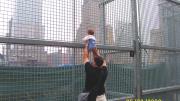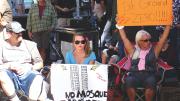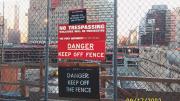In the first month after 9/11, Larry Silverstein, the real-estate developer who owned the leases to the Twin Towers, received nearly 3,000 letters telling him how and what he should rebuild. The public’s desires reflected various irreconcilable wishes: “revenge, rebirth, peace, the latest in green design, a park, commercial space, affordable housing,” writes Elizabeth Greenspan, preceptor in expository writing, in her new book, Battle for Ground Zero.
In 2001, Greenspan was a University of Pennsylvania graduate student in urban anthropology; she went to Ground Zero to investigate, and has returned many times in the last 12 years, interviewing virtually all the significant players in the resurrection of the area and writing dispatches about it for The Atlantic’s website. The Ground Zero process “is a microcosm of how things work today, and how complicated decisions are made in the public arena,” she says. “It’s really ugly—there’s a lot of dysfunction. But this is it.”
The terrorist attacks transformed a purely commercial space into, for many, a sacred burial ground. Those who saw the 16-acre site as sacred and those with a commercial interest in the land clashed politically, and as a cultural anthropologist, Greenspan studied the meanings people found in the site. “It wasn’t only because people were killed, but the way they were killed,” she explains. “A thousand people were never found; they were literally pulverized. A lot of families think of that ground as being filled with microscopic DNA.”
There were also architects “who just wanted to make a place that represented the best in urban design and architecture.” Many architects had not viewed the World Trade Center (WTC) positively. “It was a kind of urban-planning failure,” Greenspan says. WTC exemplified the “superblock” style popular in the 1960s and 1970s: “They’d take six blocks, bulldoze all the streets and sidewalks to create this giant undifferentiated space, then fill it with huge skyscrapers with huge footprints—massive buildings and no street life,” she says. “Architects felt that the tragic events of 9/11 might have a silver lining: rectifying the mistakes of the past and creating a new neighborhood, a place where people actually lived.”
Eventually, in “one of the slipperiest, most disingenuous moments” of the process, the Lower Manhattan Development Corporation (LMDC) ran a design competition to create a “master plan” for the site—even though Silverstein, the Port Authority, and the governor’s office had already decided on all the elements the site would contain: skyscrapers, a memorial, a train station. The competition was simply a contest to map the site, to assemble these pieces into an organized space. Architect Daniel Libeskind was declared the winner, though only after Governor George Pataki and Mayor Michael Bloomberg, M.B.A. ’66, overruled the LMDC’s panel of judges, architects who had chosen a plan by an architectural consortium called THINK.
Even so, Silverstein, the Port Authority, and the governor always intended to hire other individual architects to design the actual buildings. “Hardly any of the public understood this,” Greenspan explains. “They looked at Daniel Libeskind’s drawing and said, ‘OK, this is what will be built, and we’re excited about this.’ But Libeskind’s tower, which everyone had fallen in love with, was never going to be built. Larry Silverstein had hired his architect, David Childs, three weeks after 9/11.” (Childs is the architect of One World Trade Center, the primary building of the new complex.) “The only thing remaining from Libeskind’s design,” Greenspan adds, “is the height of the building—1,776 feet.”
Ultimately, the sacred-versus-commercial issue was resolved “very literally,” Greenspan says, by dividing the land evenly: half for a memorial plaza, half for office space. “It took more than 10 years to come up with that!” she says, wryly. “It doesn’t seem like the most creative, imaginative solution, but it’s good enough. What I’ve learned about the democratic process is: if you end up with something that is good enough, in our system, that’s actually not so bad.”











